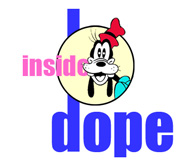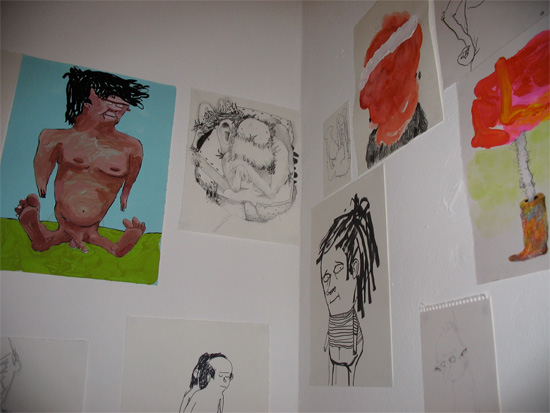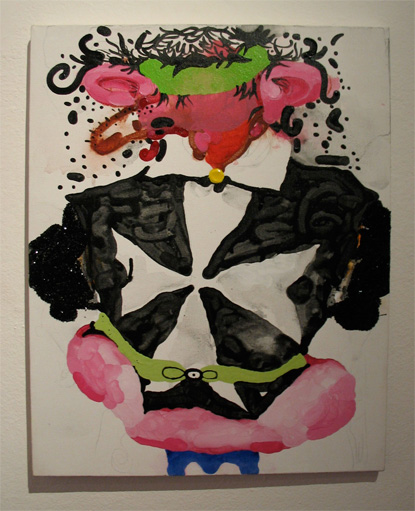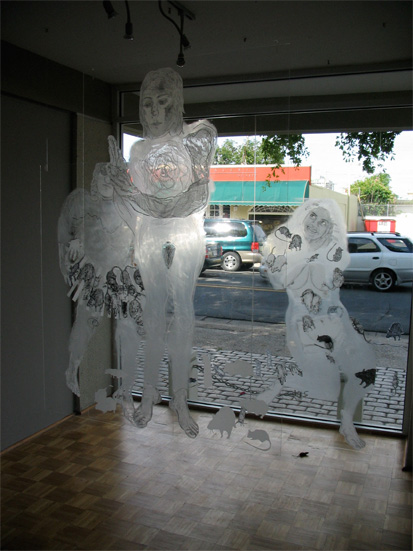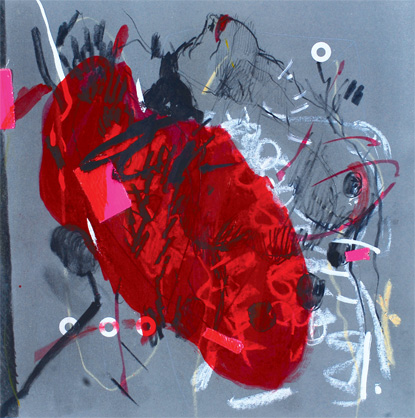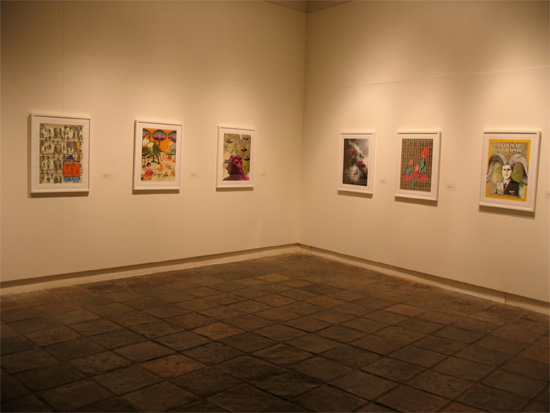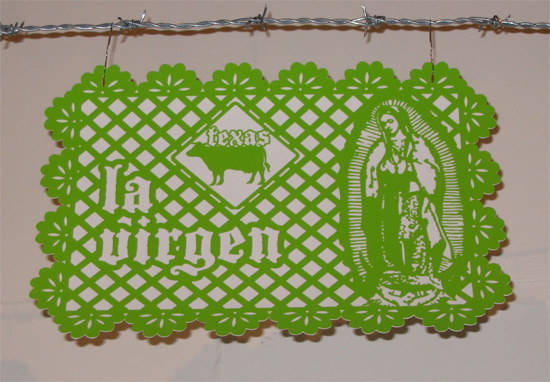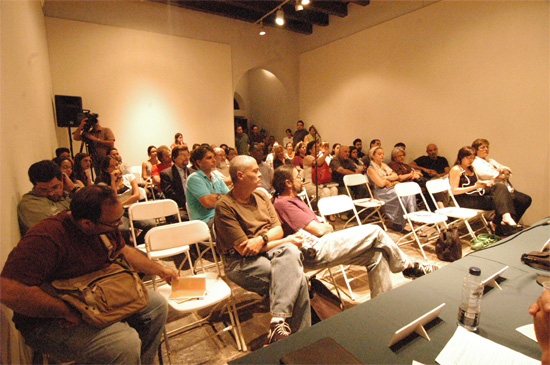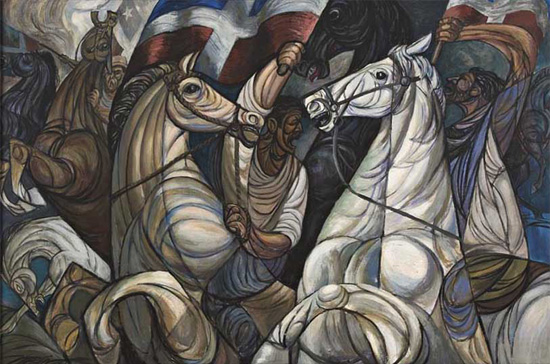|
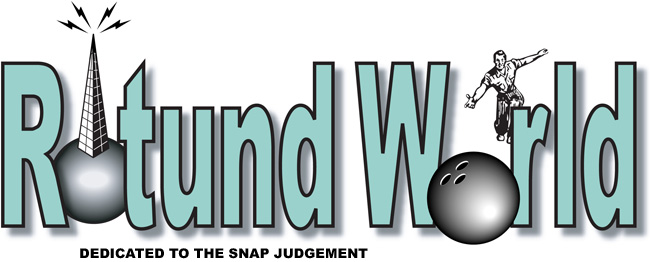
atestado, da adj crammed, stuffed
It’s been crazy, just crazy-busy hereabouts, that veritable information overload, wild, interesting stuff everywhere you look. What you see above and below are just snacks, samples of the young and the beautiful in recently opened exhibitions in San Juan. There is also, of course, the classic and the closed, represented by what has come to be known as el caballo show; a huge, eclectic painting, sculpture, and poster exhibition—also featuring other items from popular culture—which ran for several months upstairs la Ballajá. An image from that show follows, at the end of the page. First we want to alert you to the juicy offerings at Galería Candela, an exhibition of works by Roberto Márquez, which kicked off Candela’s eight-show series conceived by Abdiel Segarra and Pablo Rodríguez. Don’t wait for our verbiage. Visit Galería Candela, 110 Calle San Sebastián in Viejo San Juan, to see paintings, drawings, and installations inspired by graffiti, too much hair, foul substances, and butt cracks and similar excesses of flesh.
We like the new show at Galería 356, or at least a few things, notably Elsa Meléndez’s work, a new puppet box and revealingly newer drawings on plexiglas, plus good things from Christopher Rivera and Edgard Rodríguez Luiggi. The first image above gives you an idea of Meléndez’s drawings, hanging in the gallery’s front vestibule, and the second one shows one of Luiggi’s mixed media works. The name of this colectiva is Sin envoltura, and, as always, it’s well worth the trek to César González #356 to check it out. Call Michele at 787-282-7820, send her an e-mail, or visit the website for further details. Thanks to the gallery for the image of Luiggi’s work.
We also encourage you to visit La Puntilla where Garvin Sierra has an extensive show of 3D prints, reimagined papel picado, doctored currency, and glow-in-the-dark paraphernalia of various kinds, Que Díos te lo pague. The exhibition hangs—and stands up, for that matter—in la Sala Este of el Antiguo Arsenal de la Marina Española in Viejo San Juan. El Instituto de la Cultura Puertorriqueña keeps pretty much business hours, meaning, more or less, nine to five, Monday through Friday, though get the straight skinny by calling the office at 787-725-8320. But what we really want to talk about this morning is . . . StinkfestEeeeew, what’s that smell? It’s the stinky discussion going on in a couple print locations around San Juan, Puerto Rico, virtual and otherwise. The art community hereabouts—or perhaps it’s some other bunch who happens to hang out at gallery openings, artists’ parties, and panel discussions about art criticism—has this unsettling habit of preceding each venomous blast with a chivalrous lead-in: “Kind sir or madam, I hear what you're saying and I totally respect it, but I have to conclude your immediate ancestors probably crawled about on their bellies. And believe me when I say I'm not alone in thinking the hodgepodge you call painting-installation-video-performance smells like a dead fish. Power to the people and keep up the good work.” Is that Latin American politesse or what? It’s funny how Puerto Rico sometimes shadows Miami with the uncanny precision of, well, a boy and his shadow. We’re sorry to say we didn’t follow the story all that closely, but we did notice that early last month some of our erstwhile Florida pals mounted not one but a spate of public discussions, at least some of which concerned everyone’s favorite topic du jour, art criticism—possibly, don’t tell us, bemoaning its untimely demise or celebrating its vigor in spite of everything, or just carping and caviling as people are wont to do—and in their wake the blogsphere seemed ripe with encomiums and enough warm afterglow to inflate a good- sized plastic swimming pool. (To bathe in some of the grooviness, read accounts by the redoubtable Onajide Shabaka and Gean Moreno here and here. You can actually download podcasts of the discussions! Good going Onajide.) Well, congratulations Miami, because similar circumstances down here unleashed a torrent of free-flying, wildly histrionic abuse whose stated point was often “Fuck you for saying we’re not united and don’t get along, you piece of unspeakable foulness,” the low moment of which was, from our cringing-gringo point-of-view, “You’re probably a foreigner.” Now there is great argument. We were party to the whole affair, we admit it, but also probably the first to be bored silly by the melee. A year-and-a-half ago we helped to organize an art critic’s panel discussion with critic-curators and other hyphenated swells from all over: Santiago Olmo from Spain, Fabio Cypriano from Brazil, el DeEfe’s grande dame, Teresa del Conde, Eleanor Heartney from New York, and the island’s brilliant but, when it comes to contemporary art, highly reactionary Edgardo Rodríguez Juliá. That towering figure of Mexican social criticism, Carlos Monsiváis, was also on hand to dazzle the crowd with his usual linguistic high-wire act. It was a terrific moment, everyone dug down deep and came up with some more or less rousing version of the claim that art criticism is alive and well and serving a useful purpose. The best glow-on, though, was had by the small but rapt audience, artists mainly, a few of whom still claim, a year-and-a-half later, to have gotten something important out of the proceedings. But memories are generally woefully short, and there is a chronic abundance of snorting and gnashing of teeth about the lack of art criticism in the midst of a resurgent contemporary art scene, in spite of the fact that a few of us—Pedro Vélez, Manuel Álvarez Lezama, Javier Martínez, and when he was still living here, Elvis Fuentes, among others— write more or less analytically about what’s going on; some in the local press, some in very good blogs and online magazines, and some in various print magazines with international distribution. Vélez finally got fed up with the squawking and roped us into another round of bullshit about critical bullshit. (If you have any death threats to make or dead cats to hang on anyone’s front door, Vélez is your man.)
With the help of the director of el Programa de Artes Plásticas at el Instituto de la Cultura Puertorriqueña, Elaine Delgado, who served as moderator, we spent two evenings, first by ourselves and then in the company of several other panelists, trying to offer views about the state of art criticism on the island in a somewhat organized and more or less rational way. At the first panel it was Vélez’s initial idea to turn things around and get the audience to say what they expected from critics. The presence of the arts and entertainment editor at the island’s biggest daily newspaper, Mario Alegre Barrios, from El Nuevo Día, short- circuited this approach, however; the discussion mainly got down to whether or not the paper was doing its job with people’s press releases. Please. Well, we had our say, and in spite of the increasingly heated much ado about nothing, everyone went away satisfied that great things had been talked about. The second panel tried a different, more focused theme—its title, “Art Criticism: Catalyst for Art-making or Useless Chatter?” says it all—though each of the panelists—(from the left above) video archivist Ozzie Forbes, artist Rafael Trelles, critic-curator Mercedes Trelles (not pictured), Delgado, yours truly, Vélez, and artist-teacher José Luis Vargas—talked more about how we do what we do and why. The panelists had all done their homework, and it was a little disheartening when again the audience seemed considerably preoccupied with El Nuevo Día, although a few other things got their bases touched. Leave it to Vargas, whose painting-based installations have a creepily baroque, funny, very smart sense of theater, to give the evening its best and most original perspective, detailing how he encourages his artist students to think critically about how they see the world. At the end of the evening the Rotund crew at any rate was left with a dizzying array of emotions. We were relieved that no sharks had surfaced to rip our guts out in public, although we did hear the audible snorts at our assertion that we write seriously and lovingly about Puerto Rican art. We continue to be dismayed at the lingering confusion about the most basic tenets of art criticism. One audience member insisted—at some length—that there are reviews and then there is criticism, a proposition which thoroughly baffled us since our reviews and those of every other arts writer we know make distinctions ranging from the sniffy to the sharp, if not stooping to the savage hack jobs that exist only in legend. At the first panel, we got into it with Barrios before the official proceedings began about whether a writer who writes catalogue essays can also write criticism. It is apparently his paper’s policy, unique in the world as far as we know—and we worked at dailies in three major metropolitan areas in the U.S.—that you can either earn a living or serve the community, but you cannot do both.
It was extremely touching to hear the parade of testimony about what a great job we were doing and how we should keep it up, although it was also evident during some of these speeches that someone’s hearing aid was probably not on at the time. We still do not know for the life of us why people flock to these events and listen so attentively, and what they hear. For a short while San Juan seemed to bask in an air of accomplishment and enormous goodwill—conversations at gallery openings swirled vaguely but pleasantly around the topic of criticism, and one day when we were at a museum to write about an exhibition someone came up to us to take our picture while we worked—and this engagement in the issues at hand by itself fulfilled much of what we’d hoped for. Then something happened which we won’t even go into, we weren’t there and in any event the details of its unfolding and its importance to what followed have completely faded away, lost in what seems to be a free-floating, bottomless reserve of shrillness and rancor in a particular crevice of the artistic soul of modern-day Puerto Rico, that tiny island, after all, which just about any pretext will uncork. It all started when the hapless, but, as it turns out, completely well-meaning arts and entertainment editor, Sr. Barrios, wrote a couple of brief articles about the discussions and their aftermath, some of it less than pleasant after all, and then posted the articles on his blog, with the plea, more or less, “Can’t we all just get along?” His mistake. We’re kidding. It showed him to be a braver and more thoughtful person than we believed him to be. His tragic flaw is that he takes everything, and we do mean every fly-specking, nit-picking, wildly resentful grousing statement deeply to heart. “Mario, Mario, Mario, Mario,” we want to say to him, but we keep quiet because it’s all beginning to look and feel a to us a little ritual, a little rote in a way that’s too opaque and atavistic for a stranger, a mere foreigner, to ever understand. But the story is hardly all El Nuevo Día, and not by any means completely grim. Javier Martínez, the editor and creative force behind the culture blog Autogiro, has emerged as a watchful, thoroughly engaged observer of the contemporary art scene. He is increasingly willing to comment, and his curiosity, intelligence, and seemingly boundless attention-span give his remarks timeliness and nuance, good qualities for an scene that’s so much in flux. He’s a good, if deliberate, writer, too, which doesn’t hurt. We once criticized Martínez for holding back when we knew he had something to say, but it’s clear that Autogiro could easily surpass Rotund World for up-to-the-minute lippiness. Certainly Martínez’s range of interests is a lot broader than ours; he’s as listo covering music and theater as he is with visual art. Teresa López has a different digital project, a periodic magazine called orificio. She’s compiled four issues, one of which, #4, is available in pdf format here. We’ve added orificio to our links list, and we suggest you visit her site immediately because she’s calling for entries for her upcoming issue, #5. Like the jury for La Muestra Nacional, López is inviting some artists to create projects, and she’s also making a call for submissions. You can read all about it here, and we strongly suggest you download issue #4 to see exactly what she’s doing. In issue #4, you’ll find a highly satisfying range of projects by such artists as Adal Maldonado, Lilliam Nieves, Charles Juhasz-Alvarado, José Luis Vargas, Carlos Fajarado and Mr. Pitt von Pigg, Kristine Serviá, and Laura Bravo, among many, many others. What López is up to, as it turns out, is one of the best text-and-image-based art compendiums we’ve seen since we arrived in Puerto Rico. The deadline for submitting proposals is September 21, 2007, so get on it. We hope to have more in-depth coverage of the fresh and sinewy, all those recently- opened new shows, before they close. Stay tuned. And by the way, that image we promised you from El Caballo en la Cultura Puertorriqueña is below, one of our favorites, Augusto Marin’s 1961 oil on canvas painting, El grito de Lares.
Don’t forget BLOG. Or BLOG>>>BLOG>>>BLOG>>>BLOG>>> as the case may be. It’s Galería Candela’s next show, and it opens June 21 at 7 pm, 110 Calle San Sebastián in Viejo San Juan. As the poster indicates, this is an A-list show, if we Rotund plebes can speak of such a thing.
Next episode we hope to do some serious looking about. Please join us then, and in the meantime, you can visit our most recent outing below. Tah-tah. Stay cool. What’s been going on? Find out here if you dare. |
